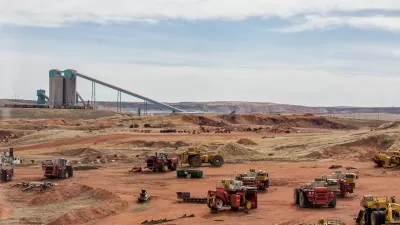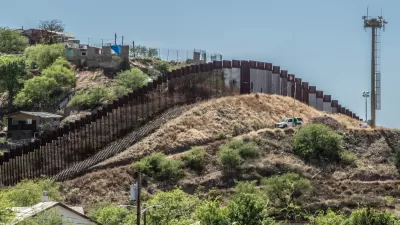Infrastructure went from playing a major role in the State of the Union address a year ago. This year infrastructure warranted barely even a nod—about 62 words, in fact.

President Donald's Trump first State of the Union address in 2018 featured 188 words on infrastructure, and plenty to talk about for weeks after the speech was done.
The infrastructure section of last year's State of the Union was classic Trump, displaying his penchant for raising the stakes of his boasts beyond expectations. In 2016, Trump the Republican candidate for president announced a $500 billion infrastructure plan. By the election in November 2016, that number had grown to $1 trillion. On the massive stage provided by the State of the Union, President Trump dropped the $1.5 trillion figure. The upward trajectory of those promises might have recalled an infomercial where the deal keeps getting better. ("But wait...there's more!")
In 2018, President Trump also promised to reduce federal permitting to a two-year process. President Trump even tacked on a "perhaps even one" to that promise. ("But wait..there's more!")
A promise to expedite permitting is a familiar refrain for politicians at every level of government. Savvy observers know to take such proclamations with a grain of salt. But, at least back in 2018 President Trump made the appearance of providing some substance to his infrastructure promises. It was Trump's tendency to sweeten the pot that brought me back to the speech this year with the hopes of the president playing at least a few cards on the subject.
Instead, Trump made no mention of the promise to expedite reviews, nor did he tack any more hundreds of millions onto any dollar figures. In 2019, here is all President Trump has to say about infrastructure:
Both parties should be able to unite for a great rebuilding of America’s crumbling infrastructure. I know that Congress is eager to pass an infrastructure bill –and I am eager to work with you on legislation to deliver new and important infrastructure investment, including investments in the cutting edge industries of the future.
This is not an option.
This is a necessity.
But wait...there must be more.
Perhaps this is President Trump waving the white flag on infrastructure. Since the 2018 State of the Union, Trump's ambitions as a great builder president have fallen far short. The details of the $1.5 trillion plan—actually just a $200 billion investment—fell far short of Trump's boasts. The plan also never had any political traction in Washington, D.C., even when the Republican Party still controlled both houses of Congress. Trump, the Republican president, started using the word "tax" when talking about how to fund his plan.
Trump's promise to speed up federal permitting in the 2018 State of the Union also yielded few results. Cabinet secretaries signed a memorandum of understanding that promised to rework environmental review processes. It would take a major leap of faith to believe the Trump administration will deliver effective reforms any time soon, despite its proven skill in clearing the way for industry to do whatever it wants without concern for the environment and public health.
Promises of FDR-level investments infrastructure, it seems, have fallen off the list of applause lines President Trump tracks at his political rallies. Instead, we get 62 words shoehorned in between promises about tariffs and the price of prescription drugs—a segue at best.
That segue doesn't even amount to much—the promise hinges on the incredibly vague words "new" and "important." Investments in "the cutting edge industries of the future" sounds more like an economic development program, or an Amazon headquarters search, than a robust campaign to solve the nation's infrastructure woes. What happened to Republicans hating the idea of governments picking winners in the economy?
Last year, it might have been possible to believe that President Trump wanted to invest time, energy, and money commensurate with the word count of the infrastructure passage of the 2018 State of the Union—even if the political feasibility of his ambitions were low to none.
There was less reason to even humor the possibility of good faith during last night's State of the Union—and that goes for almost everyone sitting on the House floor.
President Trump can't stop lying for even one day (as detailed by Daniel Dale for the Toronto Star), and the State of the Union didn't provide an occasion to end that pattern (as documented in real time last night by The Washington Post).
Despite the evidence in front of our eyes—that President Trump's boasts are based on lies and he lacks the political skill or the moral authority to achieve any of his lofty promises—the State of the Union still gives (almost every member of) Congress an occasion to stand and applaud.
***
More recommended details and analysis of the State of the Union:
- Here’s the Transcript for Trump’s State of the Union Address (Mother Jones)
- Trump’s 2019 State Of The Union: Live Coverage (FiveThirtyEight)
- I liked parts of Trump’s State of the Union; then I remembered his presidency (Vox)
- How Presidents from Trump to Washington Have Talked Cities in the State of the Union Address (CityLab)
- Trump’s odd, half-hearted pitch for infrastructure legislation (The Washington Post)
- Trump Short on Infrastructure Details in State of the Union (Route Fifty)

Trump Administration Could Effectively End Housing Voucher Program
Federal officials are eyeing major cuts to the Section 8 program that helps millions of low-income households pay rent.

Planetizen Federal Action Tracker
A weekly monitor of how Trump’s orders and actions are impacting planners and planning in America.

Ken Jennings Launches Transit Web Series
The Jeopardy champ wants you to ride public transit.

Washington Legislature Passes Rent Increase Cap
A bill that caps rent increases at 7 percent plus inflation is headed to the governor’s desk.

From Planning to Action: How LA County Is Rethinking Climate Resilience
Chief Sustainability Officer Rita Kampalath outlines the County’s shift from planning to implementation in its climate resilience efforts, emphasizing cross-departmental coordination, updated recovery strategies, and the need for flexible funding.

New Mexico Aging Department Commits to Helping Seniors Age ‘In Place’ and ‘Autonomously’ in New Draft Plan
As New Mexico’s population of seniors continues to grow, the state’s aging department is proposing expanded initiatives to help seniors maintain their autonomy while also supporting family caregivers.
Urban Design for Planners 1: Software Tools
This six-course series explores essential urban design concepts using open source software and equips planners with the tools they need to participate fully in the urban design process.
Planning for Universal Design
Learn the tools for implementing Universal Design in planning regulations.
Heyer Gruel & Associates PA
Ada County Highway District
Institute for Housing and Urban Development Studies (IHS)
City of Grandview
Harvard GSD Executive Education
Toledo-Lucas County Plan Commissions
Salt Lake City
NYU Wagner Graduate School of Public Service






























